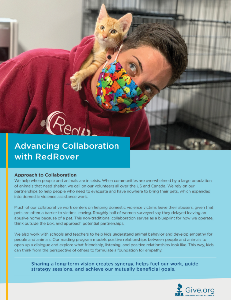
Advancing Collaboration with RedRover
About the Organization
RedRover helps animals rescued from disasters or neglect, domestic violence survivors seeking safety with their pets, and animals with life-threatening illnesses. We use innovative solutions to prevent cruelty.
RedRover staff and volunteers also provide temporary emergency shelter, resources, financial assistance, and emotional support when animals and people are in crisis. We empower educators to help kids develop empathy and awareness of animals’ well-being and increase awareness about the importance of the human-animal bond.
Featured Guest
Nicole Forsyth
President and CEO
RedRover
Approach to Collaboration
We help when people and animals are in crisis. When communities are overwhelmed by a large population of animals that need shelter, we call on our volunteers all over the US and Canada. We rely on our partnerships to help people who need to evacuate and have nowhere to bring their pets, which expanded into domestic violence assistance work.
Much of our collaborative work centers on helping domestic violence victims leave their abusers, given that pets are often a barrier to victims leaving. Roughly half of women surveyed say they delayed leaving an abusive home because of a pet. This non-traditional collaboration serves as a blueprint for how we operate, think outside the box, and approach potential partnerships.
We also work with schools and teachers to help kids understand animal behavior and develop empathy for people and animals. Our reading program models positive relationships between people and animals to open up a dialogue and explore what friendship, listening, and positive relationships look like. This way, kids can think from the perspective of others to formulate a foundation for empathy.
Build Trust
Our largest partnership, which is with Purina, has been the culmination of embracing a culture of collaboration and the nine considerations. We built trust through communication and continue to touch-base frequently, as often as weekly.
When we initially started the relationship, we began with a couple of phone calls to discover mutual goals, values, and what each of us were hoping to gain from our collaboration. Purina wanted to know what our mission needed and genuinely wanted to see more pet-friendly domestic violence shelters. From our side, we focused on being transparent with what we were hoping for and what we needed. To set the stage for trust, we were genuine to ourselves from the beginning of this relationship.
Have a Vision
We spent a lot of time discussing our vision with Purina. We both believe people and pets are better together. This notion serves as a part of their mission in fueling their products, and it’s a part of our mission in creating a better society. We both feel that if people have better relationships with their pets, they’ll also have better relationships with people. Sharing a long-term vision creates synergy, helps fuel our work, guide strategy sessions, and achieve our mutually beneficial goals.
Seek to Assure the Success of Your Collaborators
With Purina, because we built trust from the beginning, we aren’t afraid to ask for what we need, and we’re very willing to give them what they want from us as well.
Purina is looking to showcase the charitable aspect of their brand and really make a difference, so we serve as a voice to highlight their endeavors – through media placements or interviews – which helps us build a stronger rapport. We trust they have our back, and we want them to succeed, just as they hope we’ll also be successful. We also seek to ensure that the domestic violence shelters we work with are successful. This benefits the longevity of their programs and helps us carry out our mission by setting up ways the shelters can continue to stay pet friendly.
Take Stock
Strategic planning comes into play when we’re taking stock. We come together as a staff and use StrengthsFinder to assess our strengths, weaknesses, assets, and how we can maximize what we have to offer. The assessment includes taking stock of your employees’ strengths and taking stock of our collaborative partners. We knew going into the partnership with Purina that they were branding gurus, so we paired our creative employees and PR specialist with their marketing and creative engine. Through trust and the identification of our assets, we came up with our Purple Leash Project concept together. We worked on the logo and tagline together because they recognized we’re the experts in the mission and cause, just as we acknowledged their expertise in branding.
Start Small
The best example of starting small for us has been working with domestic violence shelters. Often, they are overwhelmed and may not have the capacity to invest a lot of time to change their operating practices. We use all these nine considerations when we're helping them collaborate with their community partners – especially the animal-related partners that they may have never tried to develop relationships with before.
Our role is to provide funding, which encourages domestic violence shelters to collaborate with animal shelters, veterinarians, and boarding facilities. From our experience with collaboration, we’ve learned our part has to happen delicately, offering resources, guidance and support, but letting them set the stage for when they are ready to implement a new program. Whether it starts with converting one room to be animal friendly or building a relationship with an animal shelter to ensure pets have somewhere to go, by encouraging them to start small in their collaborations, we’re able to help them build their confidence and trust.
When we were planning around five years ago, we set a goal of strategic partnerships. So when the opportunity to work with Purina presented itself, we were ready. Prior to Purina, we had smaller partnerships and many conversations, and we believe these conversations are part of the process, part of what is needed to find the right partners. We began some partnerships where our missions or goals did not align, and others where it wasn’t a true partnership but more of a one-time cause marketing situation. In conversations with 10 different corporations, there may only be one partnership that has the making for the type of capacity-building collaboration we were seeking. We keep an eye on what’s in our portfolio, fail fast, and say no when we need to.
Consider Non-Traditional Partners
We’re looking to expand our non-traditional collaborations and identify potential ways to assist in co-developing education for kids. We welcome
potential partners eager to work together to expand our education programs in schools and develop new education programs for shelters that aim to break the cycle of abuse and incorporate an animal component.
Keep Your Donors Apprised of Your Collaborations
The Purple Leash Project is an example of how we concretely involve our donors. We go above and beyond sharing the news of our corporate grants and collaboration in press releases, emails, social media posts, and newsletters by giving supporters an opportunity to join the effort and spread awareness of why more domestic violence shelters need to be pet-friendly. They can contribute and receive a Purple Leash Project leash and use it to educate others about the cause. They can also request wallet cards and download posters to share with veterinarians and stylists, two groups who are commonly told about abuse in the home.
Future Collaborations
The Collaborative for Academic, Social, and Emotional Learning (CASEL) works to promote the importance of social and emotional learning in schools. We would love to collaborate with educational
organizations like CASEL or corporations aligned to this cause, since our educational program fits well within this space. We feel we’d benefit from a collaboration with a very research-heavy non-profit because we can’t do that ourselves,
or with organizations and businesses that already have strong relationships with schools.
This article was composed by Rachel Romana Liu.



